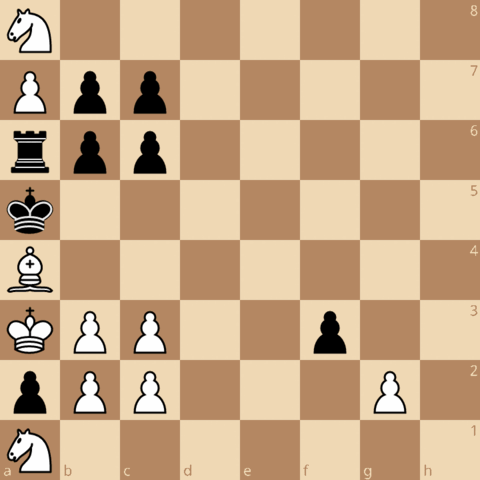Solution
The last 20 moves are:
(White retracts first) Bb5-a4 f4-f3 Bc4-b5 f5-f4 Bg8-c4 f6-f5 g7-g8=B f7-f6 f6xNg7 Ne6-g7 f5-f6 Nc5-e6 f4-f5 Na4-c5 f3-f4 Kb5-a5 f2-f3 Ra5-a6 a6-a7 Kc5-b5
You can see the proof game on Lichess here, or paste the position N7/Ppp5/rpp5/k7/B7/KPP2p2/pPP3P1/N7 and the solution into Retractor 2.
Reasoning
- The crucial problem is that Black will run out of moves to retract before it is forced to retract Kb5-a5, which will expose an illegal check by the Rook.
- We desperately need White to un-capture a Black piece, but we cannot do it with dxc2. To see this, we do a tally.
- Black is missing 8 things
- White is missing 6 things.
- White does at least 6 captures: axb3, dxc3, and e2 x ... x a6.
- Black does at least 6 captures: axb6, dxc6, and e7 x ... x a3.
By (4) and (6), we see that White's c1 bishop cannot die on its home square. This proves (2).
How can we retract? The only other way is to un-capture a Black piece (who will block the check) with the Bishop at a4 being a promoted Bishop. Assuming no wasted time, this fixes (White retracts first) Bb5-a4 f4-f3 Bc4-b5 f5-f4 Bg8-c4 f6-f5. (We will justify this assumption later)
- Black is missing 2 pawns (the g and h pawns)
- White is missing 2 pawns (the f and h pawns)
- Because of (4), (6), and (8), we see that white's f and h pawns must have promoted.
- Because of (7), (9), and the pawn on f3, there must be at least two more captures by White to clear the paths for the White f and h pawns. In particular, no Black piece can die on their home square.
- Because of (3), (7), (10), and the pawn on f3, we see that the only way to proceed is the following scheme:
- White f takes something and promotes.
- White h x g (to promote), clearing a path for Black h pawn to promote.
- Because of (11.2), we cannot have White h7xg8=B, nor can we have White h6xg7 because we haven't nearly retracted Black's promoted h pawn back to h2 yet. So we fix 2 more moves
g7-g8=B f7-f6.
- Now White is running out of moves to retract. Because of (10), Black cannot retract dxc6 to un-capture a White piece. So Black must rush (by retracting moves) to Block the check at a4. The only way to not run out of time and not give an illegal check is
f6xNg7 Ne6-g7 f5-f6 Nc5-e6 f4-f5 Na4-c5, fixing 6 more moves.
- Six more moves
f3-f4 Kb5-a5 f2-f3 Ra5-a6 a6-a7 Kc5-b5 are absolutely forced as White barely has enough moves to retract. This justifies the earlier assumption of "no wasted time".
Comments
This is a beautiful puzzle. When d7xc6 was ruled out, it seemed hopeless. This is my first retro puzzle where I have to fully "think in reverse", in terms of un-capturing and un-promotions. Eventually the only possible line came out. Thank you for the puzzle!
Retractor 2 helped me play the position in reverse (it cannot solve such a hard position). Check my edit history (1st version) for a proof game in reverse to play on that site.
It helped me to know that if less than the target number of moves (20) were forced, then it was not the solution. (So a fiendish setter might simply say "Prove or disprove this position".)
Did I see a similar position somewhere on Retro Corner? It must have been years ago.

